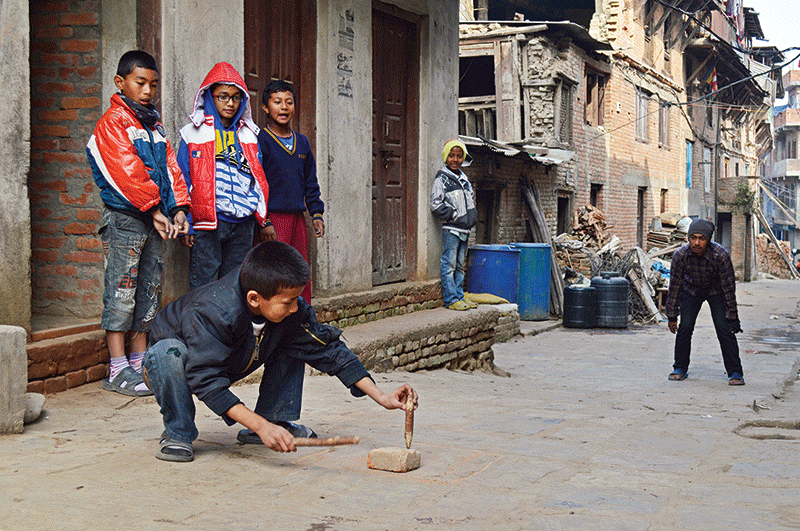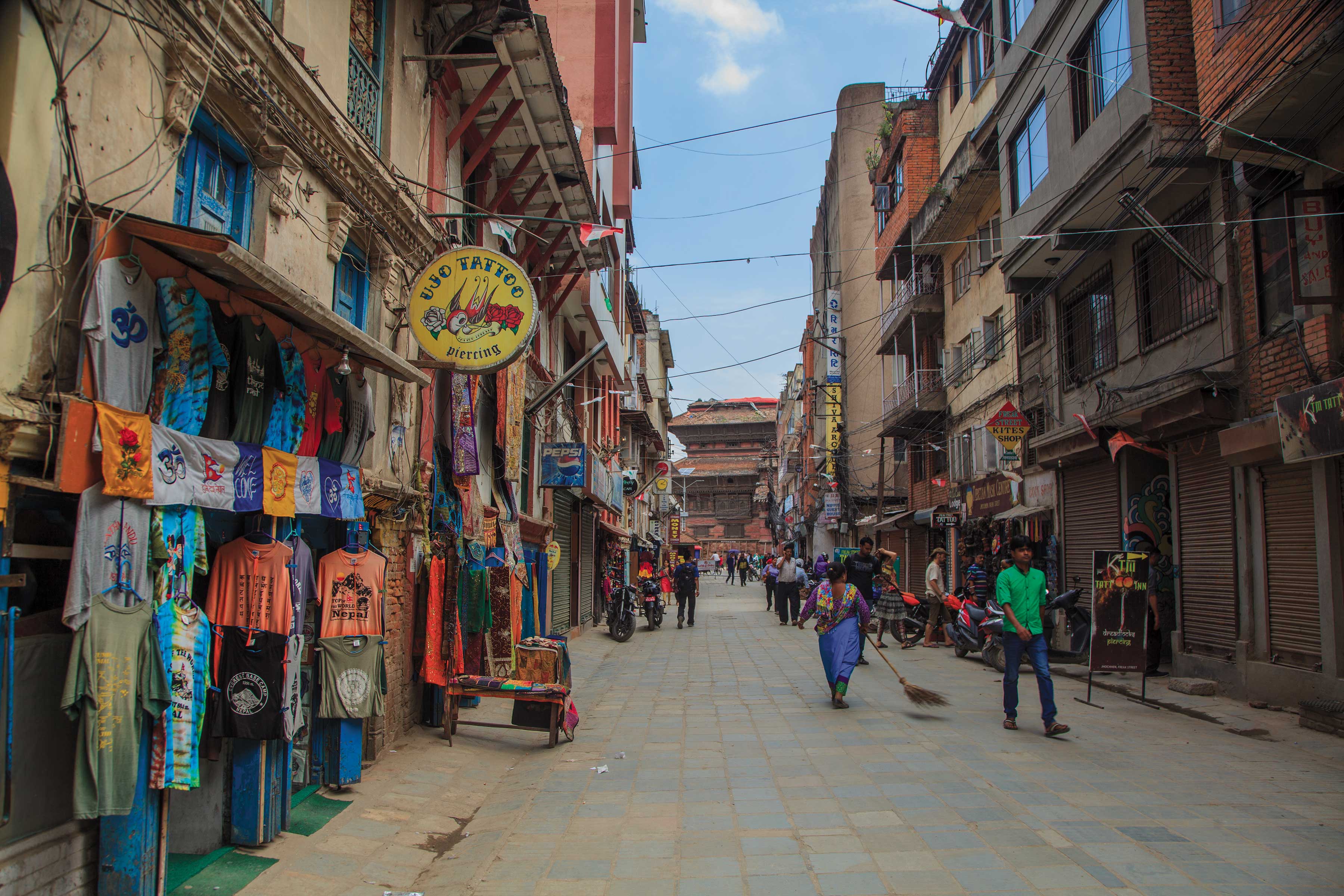It is the risk-conscious that stand to gain more out of rock climbing then a fool-hardy adrenaline junkie. It is not something that you can just go down to Thamel, get rope and start climbing.
 Rock climbing is a rapidly growing recreational activity all over the world. Beginning as one aspect to mountaineering, it has developed into a sport by itself, with specialized aspects such as bouldering and sport climbing being derived from it as well. And, with the creation of the popular indoor climbing walls, it is no longer solely an outdoor experience. As its name suggests, rock climbing involves clambering from the bottom of a rock face or cliff to the top. Using as much protective equipment and safety holds as possible, the climber needs every ounce of his physical ability and mental faculties to ascend
Rock climbing is a rapidly growing recreational activity all over the world. Beginning as one aspect to mountaineering, it has developed into a sport by itself, with specialized aspects such as bouldering and sport climbing being derived from it as well. And, with the creation of the popular indoor climbing walls, it is no longer solely an outdoor experience. As its name suggests, rock climbing involves clambering from the bottom of a rock face or cliff to the top. Using as much protective equipment and safety holds as possible, the climber needs every ounce of his physical ability and mental faculties to ascend
safely.
With so many cliffs and hills around, rock climbing seems like a sport created for Nepal. The activity is slowly gaining ground here, not just as a commercial or tourist venture, but as a personal leisurely pursuit. In particular, there are two places to climb in the valley which are easily accessible, one at Hattiban and the other at Nagarjun. The latter site is fairly convenient to reach, as it is just on the outskirts of the city limits and there is no need to book the facilities beforehand.
The Nagarjun Rock Climbing Site has a limestone rock face with 20 climbing routes at varying grades of difficulty. Despite the proximity of the routes on the narrow cliff face, climbers will hardly feel cramped up while rock climbing, unlike in other popular touristy activities. Though commercial climbing takes place at Nagarjun, it is still relatively quiet in the forested area and not crowded even on weekends, as experienced climbers head down to practice their hobby.
To skeptics, rock climbing is just as reckless as walking a tightrope over a pit of hungry tigers. One tiny misplaced step and it is an express fall to a shattering death. Rock climbing is seemingly for adrenaline junkies to have a crazy jolt of exhilaration. Though it does have that sense of achievement in overcoming difficult challenges, rock climbing is more a practical lesson in risk management and safety planning than just a spontaneous and careless act.
Being a beginner, it is only natural to be nervous. The fear of heights and, specifically, fear of falling are normal. The only way to right misconceptions about rock climbing and overcome fears is to give it a try. To allay those fears, consider asking your climbing guide about his safety setup and preparation. Seeing them set up and explain it helps lessen the worries an, at the same time, familiarizes you with the terminology and workings behind the sport. On my first climb, my guide Chandra Ale took the group of novices to the top of the cliff face to examine the permanent anchor. All safety ropes are attached onto this pivotal bolt knocked deep into the cliff face. A double anchor with equalizing system is used, which is a fail-safe system. The sturdiness of the equipment as well as the reassuring confidence of Chandra was helpful for calming my nerves.
Find a guide with experience. Check with the guide if he provides climbing shoes and helmet; if not, consider buying your personalized one especially if you are taking up the activity. Other equipment such as harnesses, bolts, carabiners and ropes will usually be provided by the guide. Look out for the UIAA (International Mountaineering and Climbing Federation) safety label which guarantees highest standards for climbing equipment.
Climbing is centered on technique more than brute strength. You do not need the physique of a weightlifter or wrestler to climb. Even such athletes might have problems at ascending. This is because the muscle groups involved in climbing are very specific. Intense conditioning, however, is still needed to get the muscles used to climbing. There are a lot of grips and holds involving the fingers and friction between the sole of the climber and the rock surface. Muscle groups, such as in the forearms, biceps and upper back, are placed under great strain for a lengthy period of time as they endure the exertion of the climber gripping tightly or hoisting himself or herself up.
For the beginner, a warm up routine is very essential to minimize the debilitating effect of ‘morning-after’ muscular aches. The warm up will ready the body and mind for the testing physical exertion to come. The routine involves stretching of those specific groups, especially the fingers and wrists. Climbers can suffer from tweaked tendons or can snap ligaments if they go up without adequately prepping the body. Include a fair bit of aerobic activity to raise the body’s pulse rate, as it is not recommended to jump from a static to vigorous state of activity. Besides stationary stretching, attempt a short one-pitch climb on a warm up route that increases mobility and works the muscles before the actual lengthy climb.
To some enthusiasts, rock climbing is like playing chess on a vertical surface. Every move requires meticulous planning within a limited time frame. Planning a route happens before the climb and during it. The former involves examining the route and spotting possible cracks for holds as well as treacherous surfaces. Handholds are on the rock surface but may not be easy to find. Spotting from the ground can only do so much, as some crevices are tucked deep into the rock surface out of sight. This requires planning on the spot, and feeling for handholds during the climb itself. Climbers need to read beyond the immediate surface and plan a sequence of moves towards the top. This is instantaneous decision-making with real dire consequences. You have to consider if a hold is ‘bummer’ (climbing lingo for describing a strong hold/grip) and whether it is too far to reach. A wrong choice and the rocks might give way. One tip is to use small steps and avoid over reaching, which can strains muscles.
“What if I fall?” This is almost every beginner’s burning question as he dons on his helmet and harness. Falling is inevitable. Even expert climbers lose their footing. The crucial thing to remember is that falling does not mean hurtling to the ground at breakneck speed. Climbers are attached to a safety rope via a robust harness, and the rope is linked to solid anchors. Climbing helps deal with managing your fears and is a lesson on risk management as it hones one sense of judgment and decision making.
Rock climbing involves more brains than what the common misconception portrays it to be. Yet physical endurance is just as necessary. Handholds are usually narrow, so fingers and forearms play a great part in giving a strong firm grip. Watching expert climbers agilely scaling the textured rock face, I had the impression that it was going to be a breeze. Yet when I was finally leaning against the rock face, I found myself grimacing, wincing and grunting. I was reaching deep into my reserves of energy just to reach out for that next hand hold. Straining my neck to look up and search for that next hold felt like an eternity as my fingers clamped tightly into the cracks. I could feel my forearms and thighs shaking uncontrollably as they strained to hold my weight. I succumbed eventually, falling off. Thankfully, I had full trust in Chandra, who belayed me from below.
A ‘belayer’ is a climber’s partner who collects the slack from the safety ropes. He or she operates like a pulley, keeping the rope taut so that if climber falls the rope will hold and halt the fall. The taut rope also prevents any shock load being exerted on the climber if he falls. ‘Shock load’ is the force exerted on a falling climber when he suddenly stops, with the body feeling the jarring shock of the sudden halt.
“Trust (in your belayer) is absolutely essential,” says Rob Fenn, a climbing enthusiast and a regular at Nagarjun. “If you are not confident in your belayer, then you should not be climbing with him,” he advises. Rob, who used to climb a lot on rocky crags in the United Kingdom, believes that rock climbing encourages teamwork and responsibility and goes as far to suggest allowing children to try it, so long as all safety precautions are taken.
It sure takes more than just guts to be a good climber. Strength of mental will and sensible bravado are equally if not more important than possessing technical skills and finesse. Physical endurance is a must, but that can be developed as one progresses through varying levels of climbing difficulty. The limit you scale to depends ultimately on your threshold of risk acceptance and body conditioning. Learning the right techniques improves one’s competence and with skill comes that confidence to negotiate the rock walls and scale fearlessly to the top.










